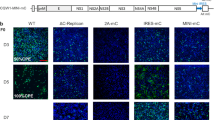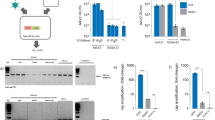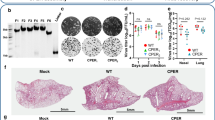Abstract
This report describes a transfection-independent system for packaging alphavirus replicon vectors using modified vaccinia virus Ankara (MVA) vectors to express all of the RNA components necessary for the production of Venezuelan equine encephalitis (VEE) virus replicon particles (VRP). Infection of mammalian cells with these recombinant MVA vectors resulted in robust expression of VEE structural genes, replication of the alphavirus vector and high titers of VRP. In addition, VRP packaging was achieved in a cell type (fetal rhesus lung) that has been approved for the manufacturing of vaccines destined for human use.
This is a preview of subscription content, access via your institution
Access options
Subscribe to this journal
Receive 12 print issues and online access
$209.00 per year
only $17.42 per issue
Buy this article
- Purchase on Springer Link
- Instant access to full article PDF
Prices may be subject to local taxes which are calculated during checkout

Similar content being viewed by others
References
Dubensky, T.W., Polo, J.M. & Jolly, D.J. in Gene Therapy: Therapeutic Mechanisms and Strategies (eds. Templeton, N.S. & Lasic, D.D.) 109–130 (Marcel Dekker, New York, USA 2000).
Rayner, J.O., Dryga, S.A. & Kamrud, K.I. Alphavirus vectors and vaccination. Rev. Med. Virol. 12, 279–296 (2002).
Driver, D.A. et al. Layered amplification of gene expression with a DNA gene delivery system. DNA vaccines. 772, 261–264 (1995).
Davis, N.L., Brown, K.W. & Johnston, R.E. A viral vaccine vector that expresses foreign genes in lymph nodes and protects against mucosal challenge. J. Virol. 70, 3781–3787 (1996).
Hevey, M., Negley, D., Pushko, P., Smith, J. & Schmaljohn, A. Marburg virus vaccines based upon alpavirus replicons protect guinea pigs and nonhuman primates. Virology 251, 28–37 (1998).
Davis, N.L. et al. Vaccination of macaques against pathogenic simian immunodeficiency virus with Venezuelan equine encephalitis virus replicon particles. J. Virol. 74, 371–378 (2000).
Davis, N.L. et al. Alphavirus replicon particles as candidate HIV vaccines. IUBMB Life 53, 209–211 (2002).
Frolov, I. et al. Alphavirus-based expression vectors: strategies and Applications. Proc. Natl. Acad. Sci. USA 93, 11371–11377 (1996).
Pushko, P. et al. Replicon-helper systems from attenuated Venezuelan equine encephalitis virus: expression of heterologous genes in vitro and immunization against heterologous pathogens in vivo. Virology 239, 389–401 (1997).
Smerdou, C. & Liljestrom, P. Two-helper RNA system for production of recombinant Semliki Forest virus particles. J. Virol. 73, 1092–1098 (1999).
Polo, J.M. et al. Stable alphavirus packaging cell lines for Sindbis virus and Semliki Forest virus–derived vectors. Proc. Natl. Acad. Sci. USA 96, 4598–4603 (1999).
Weiss, B.G. & Schlesinger, S. Recombination between Sindbis virus RNAs. J. Virol. 65, 4017–4025 (1991).
Berglund, P. et al. Semliki Forest virus expression system: production of conditionally infectious recombinant particles. Bio/Technology 11, 916–920 (1993).
Sutter, G. & Moss, B. Nonreplicating vaccinia vector efficiently expresses recombinant genes. Proc. Natl. Acad. Sci. USA 89, 10847–10851 (1992).
Kovacs, G.R., Parks, C.L., Vasilakis, N. & Udem, S.A. Enhanced genetic rescue of negative-strand RNA viruses: use of an MVA-T7 RNA polymerase vector and DNA replication inhibitors. J. Virol. Meth. 111, 29–36 (2003).
Chakrabarti, S., Sisler, J.R. & Moss, B. Compact, synthetic, vaccinia virus early/late promoter for protein expression. BioTechniques 23, 1094–1097 (1997).
Davis, N.L. et al. Attenuating mutations in the E2 glycoprotein gene of Venezuelan equine encephalitis virus: construction of single and multiple mutants in a full-length cDNA clone. Virology 183, 20–31 (1991).
Carroll, M. & Moss, B. Host range and cytopathogenicity of the highly attenuated MVA strain of vaccinia virus: propagation and generation of recombinant viruses in a nonhuman mammalian cell line. Virology 238, 198–211 (1997).
Monroe, S.S. & Schlesinger, S. RNAs from two independently isolated defective interfering particles of Sindbis virus contain a cellular tRNA sequence at their 5′ ends. Proc. Natl. Acad. Sci. USA 80, 3279–3283 (1983).
Velders, M. et al. Eradication of established tumors by vaccination with Venezuelan equine encephalitis virus replicon particles delivery human papillomavirus 16 E7 RNA. Cancer Res. 61, 7861–7869 (2001).
Acknowledgements
We thank Bernard Moss and Linda Wyatt for providing the vaccinia virus vector plasmids and MVA, and Jonathan Smith, Mike Parker, Peter Pushko and Kurt Kamrud for helpful discussions and technical advice with the VEE expression system.
Author information
Authors and Affiliations
Corresponding author
Ethics declarations
Competing interests
The authors declare no competing financial interests.
Rights and permissions
About this article
Cite this article
Vasilakis, N., Falvey, D., Gangolli, S. et al. Transfection-independent production of alphavirus replicon particles based on poxvirus expression vectors. Nat Biotechnol 21, 932–935 (2003). https://doi.org/10.1038/nbt845
Received:
Accepted:
Published:
Issue Date:
DOI: https://doi.org/10.1038/nbt845
This article is cited by
-
Facile method for delivering chikungunya viral replicons into mosquitoes and mammalian cells
Scientific Reports (2021)
-
Broad-spectrum agents for flaviviral infections: dengue, Zika and beyond
Nature Reviews Drug Discovery (2017)



